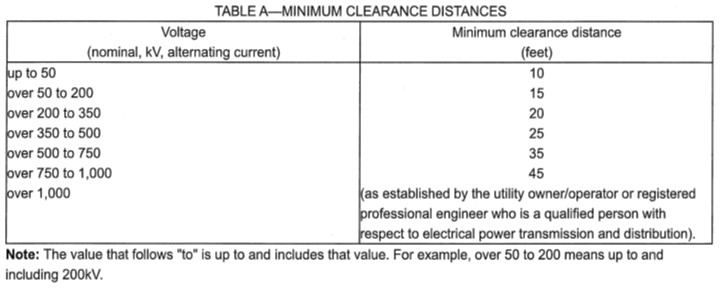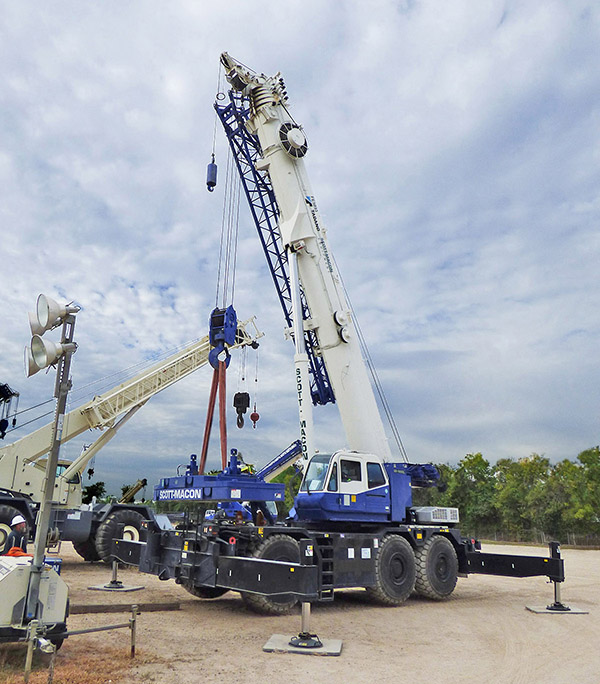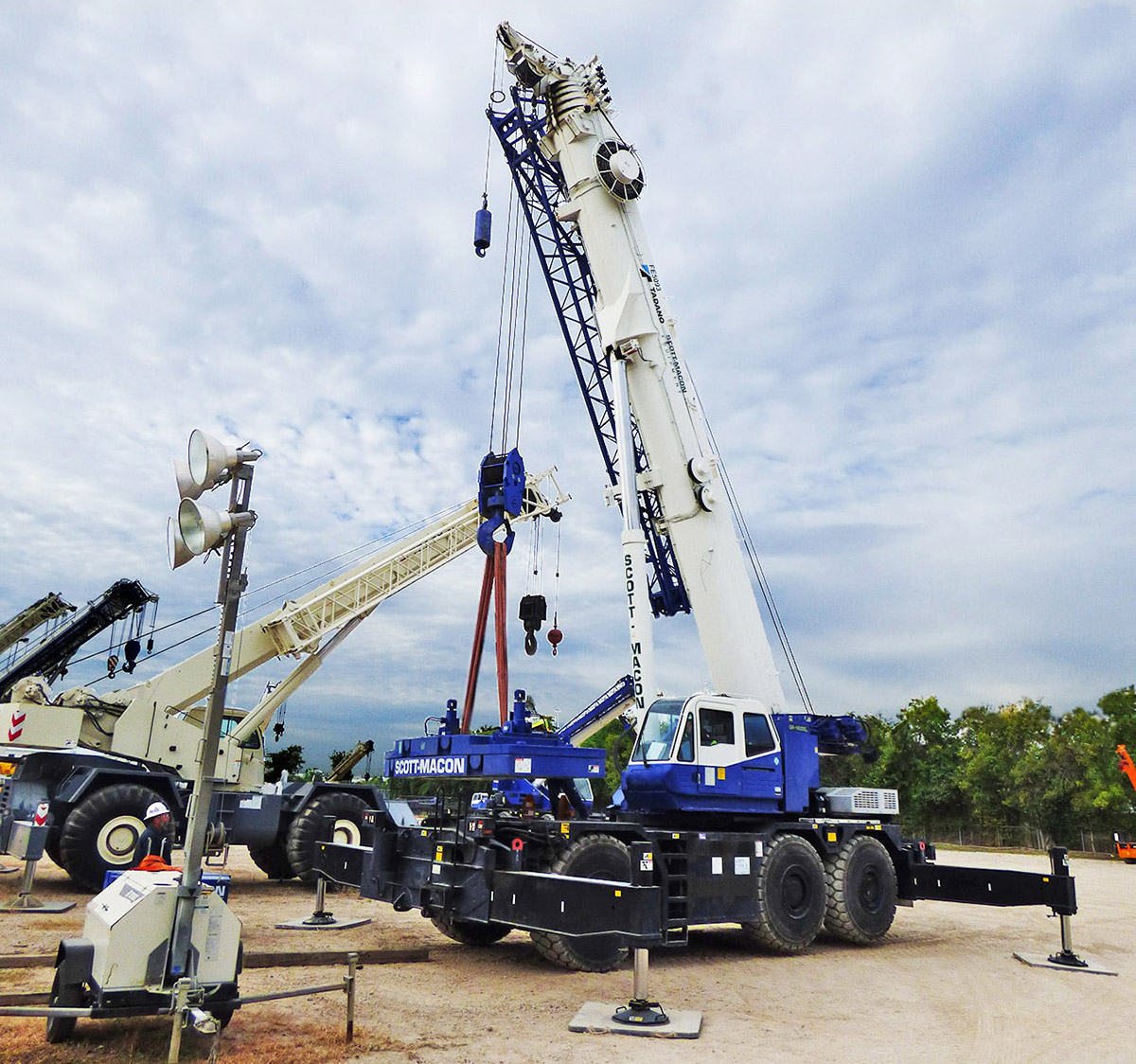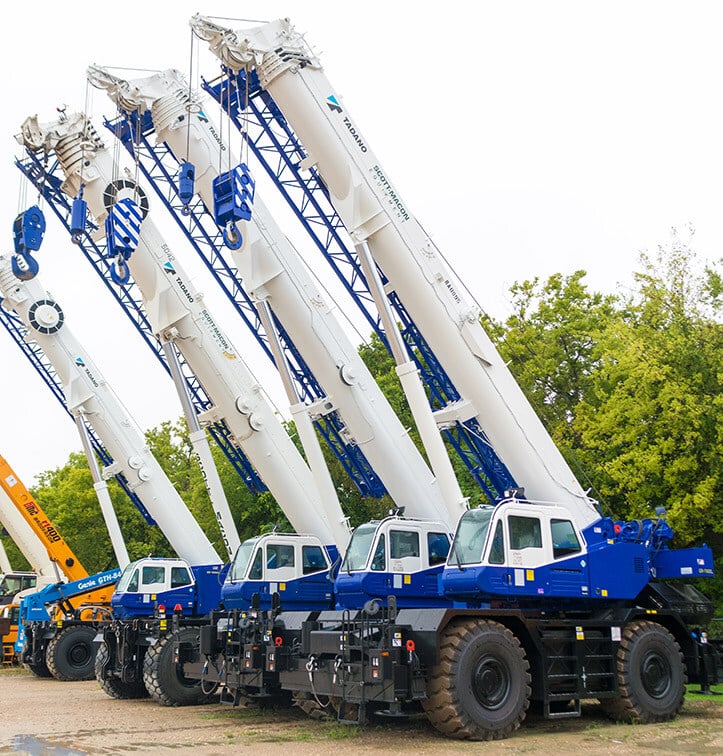Crane safety guidelines need to be followed at all times to help keep crane operators and those around them safe at the jobsite. When any of these guidelines are overlooked, it can lead to major safety issues – possibly resulting in equipment damage or injury to the operator or other personnel. Here are some tips to help you stay safe and avoid some common mistakes that can lead to accidents.
Crane Location Considerations
Carefully consider the location of the crane. Look for possible physical obstructions both on the ground and in the air. Make sure there is adequate operational clearance for the crane and the load for the tasks to be completed. If needed, adjustments may need to be made such as changing the plan for the lift, moving an obstruction, or relocating the crane.
Be sure to check for power line clearances. When working around or near electrical power lines, limit crane operations to a minimum clearance of 10 feet from all energized lines of 50 kV (kilovolts). For additional minimum clearances information for cranes, see Table A below (OSHA 29 CFR 1926.1408).

High Temperatures
Be sure the ground is level and stable, enough for the crane’s weight plus the load. Improper ground support can lead to accidents and damage to the crane. Determine if outrigger mats or blocks are needed. Many manufacturers’ operator’s manuals state that the crane’s own outrigger pads/floats by themselves may not provide enough support for all ground conditions. Properly blocking and/or matting distributes the weight of the crane and the load over a greater surface area. This reduces the amount of ground pressure per the contact area, which increases the stability of the crane. Also, If the crane is going to be set up near an excavation, the crane should be a minimum distance away of at least one and a half times the depth of the excavation. More distance that is still safe and practical is even better.
Correct Crane Configuration and Setup
Proper assembly and setup of any crane is essential to ensure that it is operating as safe as possible. Improper crane setup can lead to unsafe issues, malfunctions, and even collapse. These are problems that can be avoided. Many Injuries and deaths among construction workers have been the result of cranes accidents, where in most cases, improper crane setup was at the root of the cause.
Prior to use, the crane should be inspected to verify compliance with the manufacturer’s specifications for safe operations. Ensure that the load charts are specific for the crane and follow them closely. Make sure the crane is properly set up and configured for safe operation for the lift operation to be done. Verify that the crane has the proper counterweight(s) installed for the type of lift. The load block must be properly reeved with the proper parts of line of wire rope for the amount of load to be lifted. If a boom extension is needed, that may need to be installed.
Visually check that all outriggers are properly set for maximum crane stability per the load chart/crane mode being used, including any additional outrigger pads that are needed. If used, the pads must be positioned properly and made of a strong, durable material. They must also be the right size and strong enough to endure the weight of the crane and its load. For more detailed information, view our DICA outrigger pads page: DICA Outrigger Pads | Scott-Macon Equipment (smequipment.com)
Proper LMI Settings
A crane’s LMI (Load Moment Indicator) setup is very important to maintain crane safety. When set properly, the LMI is used to prevent the crane from going past any permissible operational limits. This helps to keep the crane from collapsing or tipping over due to a possible overload or unstable condition.
This device may display several pieces of information such as the crane’s rotational position, capacity, and load indication on the hook. Both audible and visual warnings are sent when an overload, two-block, or unstable situation occurs. The correct LMI operating mode must be used and match the crane’s configuration, so the LMI can help keep the crane from overloading or tipping over. Keep in mind that when the crane setup changes, the correct mode in the LMI must also be reset.
Active A2B Systems
The term “two-blocking” is used in the crane industry to describe a situation where the load block or overhaul ball of the crane comes into contact with the main boom nose, auxiliary nose, or the nose of the boom extension. When unchecked, two-blocking can occur when hoisting up the load block or auxiliary ball, telescoping out, or booming down. This can cause crane damage and possible injury or death to personnel.
Anti-Two-Block or “A2B” systems are standard equipment with modern cranes. These fail-safe type systems can help prevent two-block situations. However, they cannot protect the crane or personnel if they are not set up and used properly or not used at all. Faults can also occur when the A2B system is set up improperly, bypassed, damaged, defective, or improperly installed. Failure to properly use the A2B system can be a costly oversight.
Using Qualified Operators
It’s important to note that not all cranes have the latest safety devices and technology. Accidents caused by operator error happen all too frequently. Inexperienced and unqualified operators can be a liability to the company that employs them. The costs incurred due to accidents at the job site from an operator that has not been properly trained can be astronomical. Not only is the cost to repair cranes expensive, but the downtime at the site from damaged property or injured personnel add up quickly.
An incompetent operator that is not properly trained or is unfamiliar with the crane being used can possibly cause an accident in a number of ways. Overloading the crane is a common safety issue that can eventually cause the crane to tip over or have a structural failure. Problems can also occur when details of the lift and placement of the load (pre-planning) is not communicated correctly or understood by the operator. Even an incorrect crane function could be activated by the operator, resulting in crane damage and/or personnel injury.
Maintaining crane safety is based on the ability, knowledge, and experience of the operator, their understanding of the crane and its capabilities, along with their ability to use and understand the load charts. It should also be mentioned that operators need to have a good basic knowledge of rigging as well, since rigging is a fundamental part of crane operations.
Attention to Environmental Conditions
Ignoring hazardous environmental conditions can lead to costly and sometimes deadly consequences. Supervisors and crane personnel need to be constantly aware of current weather conditions as part of safe crane operations. Weather reports should be checked regularly, and workers should be aware of weather conditions while on the job. Lifts may need to be rescheduled to avoid workers being caught in dangerous weather. Some of the environmental conditions to be aware of are high winds, high temperatures, low temperatures, heavy rain, and lightning strikes.
High wind speeds and gusts can create problems for cranes. They can push the load and swing it sideways and/or inward or outward. Depending on the lift parameters, this may create stability or structural problems for the crane. Some crane manufacturers recommend cancelling or derating lifts when wind speeds reach 20-25 mph. Even without a load, if the wind speed is excessive and enough of the boom is exposed, the crane can potentially tip over.
Hot temperatures can affect both equipment and personnel. If the crane has a weak engine cooling system, the engine may overheat causing operational problems or failure. Excess heat can also cause some personnel (including the crane operator) to develop heat stress which will negatively affect their ability to do their task.
Conversely, if the environmental temperature is too cold, a crane’s hydraulic system can slow down from reduced fluid speed due to thickening of the hydraulic oil. Excess cold may also make starting the crane difficult. Extreme cold below 0 degrees Fahrenheit can even reduce the crane’s structural tensile strength, leading to possible damage or failure. A reduction of 25% of load chart capacity may be recommended at these temperatures. Besides affecting the crane, exposed personnel may experience hypothermia which can affect their ability to work.
Heavy rain itself can affect crane operations by reducing the visibility between the operator and ground personnel, interfering with visual communications. Heavy rain may also have an impact on the ground surface bearing the crane. The ground could become too soft to provide a reliable foundation without adequate matting.
Thunderstorms are serious problems too. A lightning strike can partially or completely damage a crane’s electrical or computer system. This may cause a partial or total power failure, thereby possibly affecting the LMI system. Damage to the crane’s LMI or anti-two-block systems can potentially cause a loss of load or the crane’s operation to become erratic. The crane boom and any load should be lowered if possible when lightning is in the vicinity or surrounding areas. The National Weather Service mentions that lightning often strikes more than three miles from the center of the thunderstorm. Personnel should wait until 30 minutes after the last sound of thunder before resuming crane operations.
Conclusion
Paying close attention to guidelines is always the best way to operate a crane or any heavy equipment. Take the necessary steps to avoid costly crane-related accidents by making sure that the crane is in proper working order, is set up correctly, is safe to operate, and operated safely. The more you know about crane safety, the safer you and everyone else will be at the job site.
For additional articles, click here: Blog | Scott-Macon Equipment (smequipment.com)












Comment